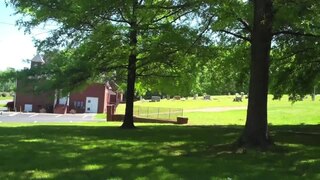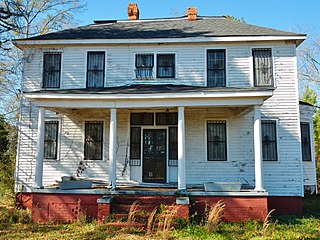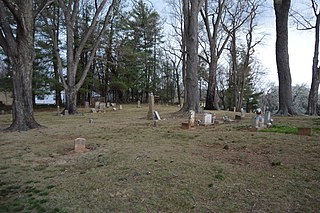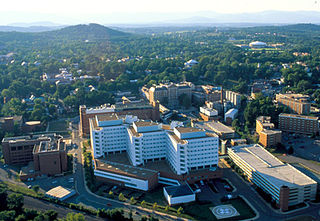
Crozet is a census-designated place (CDP) in Albemarle County in the Commonwealth of Virginia. It is situated along the I-64 corridor approximately 12 miles (19 km) west of Charlottesville and 21 miles (34 km) east of Staunton. Originally called "Wayland's Crossing," it was renamed in 1870 in honor of Colonel Claudius Crozet,the French-born civil engineer who directed the construction of the Blue Ridge Tunnel. The corner stone of Crozet is believe to have been Pleasant Green, a property also known as the Ficklin-Wayland Farm, located just about 100 30 yards from the actual Wayland Crossing. Claudius Crozet is said to have lodged in that property while surveying the land that today honors his name. The population of Crozet was 5,565 at the 2010 census. Crozet is part of the Charlottesville Metropolitan Statistical Area.
Philip C. Jimeno is an American politician and was a long-serving member of the Maryland State Legislature as a Democrat. He attended Fairmont State College in his hometown. He was married in 1969, and he and his wife Ramona moved to Brooklyn Park, Maryland in 1970. He worked as a probation and parole officer in Baltimore and was involved in the local improvement association, the Roland Terrace Democratic Club and became president of the Greater Brooklyn Park Council. In 1978, he decided to run for a seat in the Maryland House. He won that election, and went on to represent District 31 in the Maryland State Legislature from 1985 until his retirement in 2007. In more than two decades of service, Mr. Jimeno missed just one day of the General Assembly session when a snowstorm left him unable to get out of his driveway.

Lewis Adams was an African-American former slave in Macon County, Alabama, who is best remembered for his work in helping found the school in 1874 in Tuskegee, Alabama which grew to become the normal school that with its first principal, Booker T Washington, grew to become Tuskegee University.

In informal usage, a Rosenwald School was any of the more than five thousand schools, shops, and teacher homes in the United States that were built primarily for the education of African-American children in the South during the early twentieth century. The project was the product of the partnership of Julius Rosenwald, a Jewish-American clothier who became part-owner and president of Sears, Roebuck, and Company and the African American leader, educator, and philanthropist, Booker T. Washington, who was president of Tuskegee Institute.
Charlottesville Catholic School (CCS) is a private school under the jurisdiction of the Diocese of Richmond. It is a day school for pre-kindergarten through 8th grade. The school is located on 49 acres (200,000 m2) in unincorporated Albemarle County, Virginia, United States, near Charlottesville. The school provides Spanish, Latin, theatre, clubs, sports teams, and more. The institution is currently 22 years old, having been founded in 1996.

The Calhoun Colored School (1892–1945) was a private boarding and day school in Calhoun, Lowndes County, Alabama, about 28 miles (45 km) southwest of the capital of Montgomery. It was founded in 1892 by Charlotte Thorn and Mabel Dillingham, from New England, in partnership with Booker T. Washington of Tuskegee Institute, to provide education to rural black students. African Americans comprised the majority in this area, and the state had segregated facilities. Calhoun Colored School was first designed to educate rural black students according to the industrial school model common at the time.

Booker T. Washington High School, named for the famous educator, opened in September 1924 under the auspices of the Atlanta Board of Education, with the late Charles Lincoln Harper as principal. It was the first public high school for African-Americans in the state of Georgia and the Atlanta Public Schools system.

The Robert Hungerford Preparatory High School was founded by Professor and Mrs. Russell C. Calhoun in 1897. The school was located in Eatonville, Florida, one of the first African American towns to incorporate in the United States. Both the professor and his wife attended the Tuskegee Institute, of which the husband was a graduate. In the spring of 1898, along with the help of friends and relatives, Mr. E C. Hungerford donated to the school 160 acres (65 ha) of land. Mr. Hungerford of Chester, CT. owned a winter home in nearby Maitland, Florida. The land was donated in memory of his late doctor son, Robert, who died due to yellow fever. Robert had cared for a sick African American boy who no one else would help, even when Robert himself became ill.

Peabody High School is a secondary educational institution located in the South Alexandria subdivision of Alexandria, the seat of Rapides Parish and the largest city in central Louisiana. The school is named for one of its benefactor, George Foster Peabody (1852–1938), a London capitalist who promoted the furthering of education in the Southern United States.

Benjamin Oliver Davis Jr. was an American United States Air Force general and commander of the World War II Tuskegee Airmen.
Andrew Fowler was an influential Baptist minister, pastor, educator, school administrator, counselor, political and religious adviser, church statesman, and civil rights activist in the nation's capital for more than six decades.

Noel Francis Parrish was a Brigadier General in the United States Air Force who was the white commander of a group of black airmen known as the Tuskegee Airmen during World War II. He was a key factor in the program's success and in their units being assigned to combat duty. Parrish was born and raised in the south-east United States; he joined the U.S. Army in 1930. He served in the military from 1930 until 1964, and retired as a brigadier general in 1964.
Dr. Allen Easter Ericson Weatherford was a professor of physical education and the first black man to earn a doctorate in the subject.

Daughters of Zion Cemetery, also known as Zion Cemetery, Society Cemetery, and Old Oakwood Section, is a historic African-American cemetery located at Charlottesville, Virginia. It was established in 1873, and contains an estimated 300 burial sites with 152 of the burials commemorated with 136 surviving grave markers. It consists exclusively of marble and granite grave markers with a single 20 foot by 20 foot section enclosed with a cast iron fence. Notable burials include Benjamin Tonsler (1854-1917), who built the Benjamin Tonsler House. The city assumed title to the property in the 1970s, and the last burial occurred in 1995.
Albemarle Training School was a segregated school for African American students in Albemarle County, Virginia. It was located north of Charlottesville near what is now the Ivy Creek Reservoir. It was built on the site of the Union Ridge Graded School after that building burned down in 1893. The school served all grades, and is notable for being the first four-year high school for African American students in Albemarle County. In 1951, its students were transferred to the new Burley High School in Charlottesville, and the facility became an elementary school until closing in 1959.















